Most of these pictures are from a 2 mile (105 runtotal) tour of Ute Prayer Trees in Fox Run Regional Park. These trails can be found all over the Pikes Peak region but they are especially abundant in Black Forest. Once you learn what to look for you may find more than you expect.
 |
| These three are Pikes Peak from earlier in the week, taken near where I work. |
 |
| This one is a juvenile Mississippi Kite from 9/5 - the last day seen this season. |
 |
| A cool spider at Clear Spring Ranch on Labor Day |
 |
| Bear tracks in Little Fountain Creek at Clear Spring Ranch. |
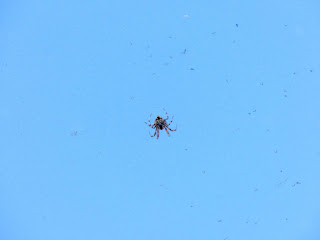 |
| A neat spider down at Fountain Creek on 9/12. |
 |
| Some fall color seen from the tunnel (Horsethief Falls/Pancake Rocks) on highway 67 on the way to Cripple Creek 9/13. |
 |
| This is a Ute Prayer Tree (UPT). The bark was removed by a Medicine Man. |
 |
| This UPT is a trail marker tree. They have a 30 (or so) degree bend to vertical. These trees may point the way along historic trails or to other important trees, to Pikes Peak, to water, etc. They often occur in pairs. |
 |
| This is a blaze made with an axe - old, but more likely not by someone of European as opposed to Native decent. |
 |
| This is a burial tree - two 90 degree bends. The direction the tree points indicates something significant about a particular deceased person - the place of burial, death, or perhaps birth. |
 |
| One key thing to look for in UPT's are ligature marks like these where Utes forced them to bend and grow certain directions. |
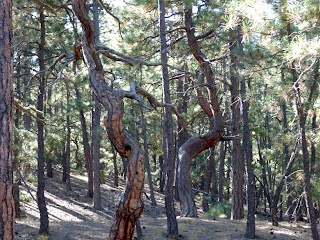 |
| These are Ceremonial or Story trees. No one alive knows the stories or ceremonies associated with these twisty trees anymore. |
 |
| The burl on the story or ceremony tree is man-made. |
 |
| This one looks a little like a burial tree, but the angle is off, so is considered a trail marker tree. It is very old, around 450 years. The little 'crack' feature was done to help the tree stay bent when it was made. |
 |
| Carol sitting on one of the older trees in Fox Run Park, a sacred UPT. |
 |
| Kinnikinnik berries. |
 |
| Animal tree modification - woodpecker style! |
 |
| This is another ceremony/story tree. |
 |
| This tree had bark removed high up the tree - a medicine tree. The cambium layer was used for food, medicine and making cradle boards. |
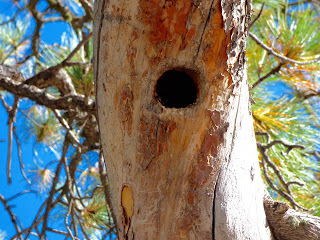 |
| Another animal modification. We saw several pygmy nuthatches using holes like these. |
 |
| The Grandmother tree. Perhaps 400 years old. |
 |
| Old Ponderosas turn orange. They may live 600-800 years or more. This one is about 400 years old. |
 |
| The Grandmother tree is one of the largest and most sacred UPTs in the park. It is a story tree, but its story is lost. |
 |
| Many culturally modified trees aren't round - they have an oval shape due to weight redistribution when it is bent. |
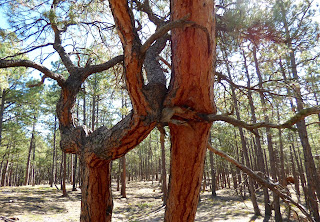 |
| This pair of trees have been purposefully intermixed to form a Prophecy Tree - one of the most rare types of UPTs that were actually used to foretell. This pair is called the Portal tree because under where they are fused together there is a portal to walk through toward Pikes Peak. |
 |
| The fusion of the trees involved burning and cutting into one tree so the other would join it. |
 |
| Carol prepares to pass through the portal. The goal post style tree was known among Cheyennes to indicate territorial boundaries. It is unknown if the Portal tree is associated with a boundary. |
 |
| This Prophecy Tree is a pair of trees considered perhaps the most sacred in the park or in all of Black Forest. The smaller tree appears to hug the larger. These are located in a quiet section of the park away from the trails. This is nicknamed the Hugging Tree. |
 |
| This trail marker tree we found as we navigated out points directly to the Hugging Tree, as you can see below. |
 |
| There are still a few flowers around but fall was definitely in the air today - it was brisk and lovely. |
 |
| This recently cut tree just made an awesome picture - kind like a Tesla Coil. |
 |
| Fall color in the ground cover. |
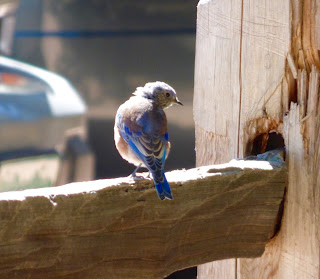 |
| There were many young (or molting?) Western Bluebirds in the park. |
















































3 comments:
Nice photos, Diana! I will post mine later today or tomorrow, and I'll send you the link. Thank you for a great time in the sacred trees!
Did you mean to say the goal post tree was known among "Cheyenne"... ? I believe all these trees were modified by the Ute only?
Laura - I think that is not certain. Most were made by Utes but Cheyennes also made some and also used some made by the Utes and have oral history about them.
Post a Comment